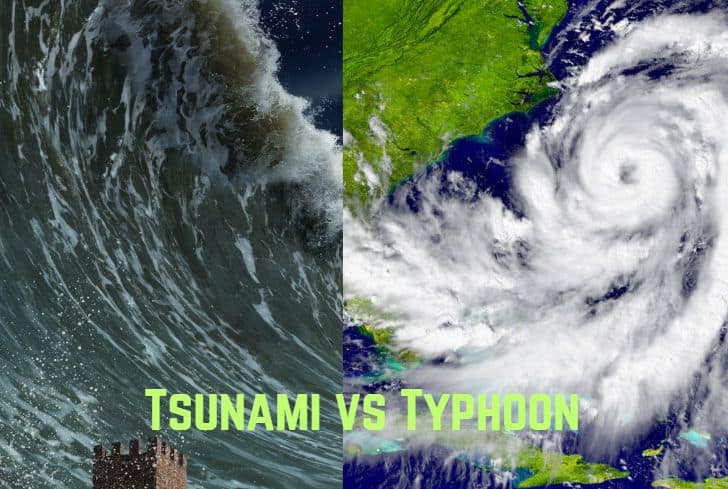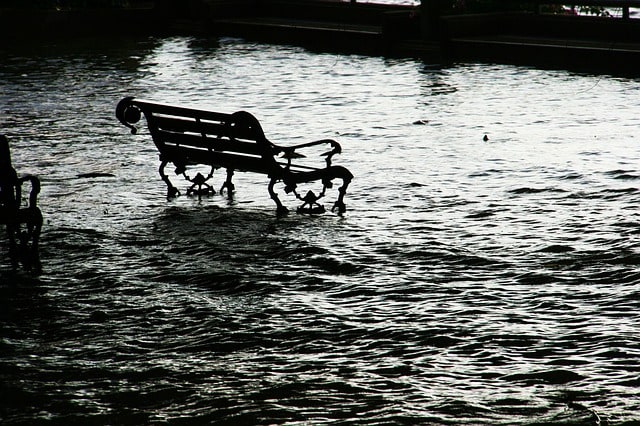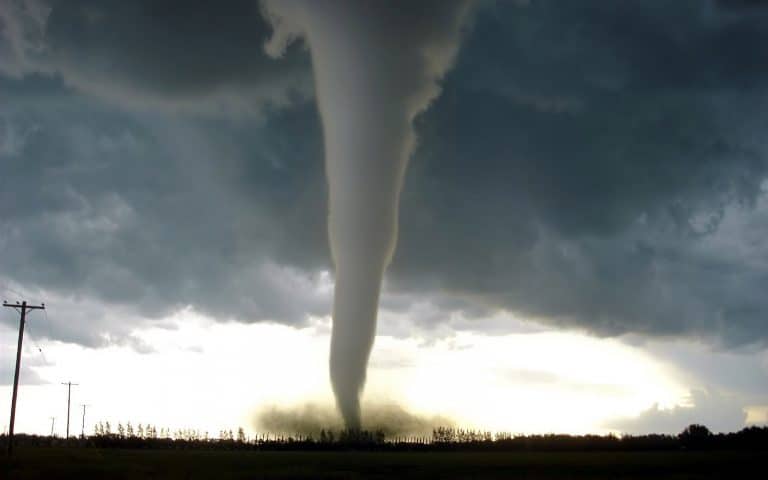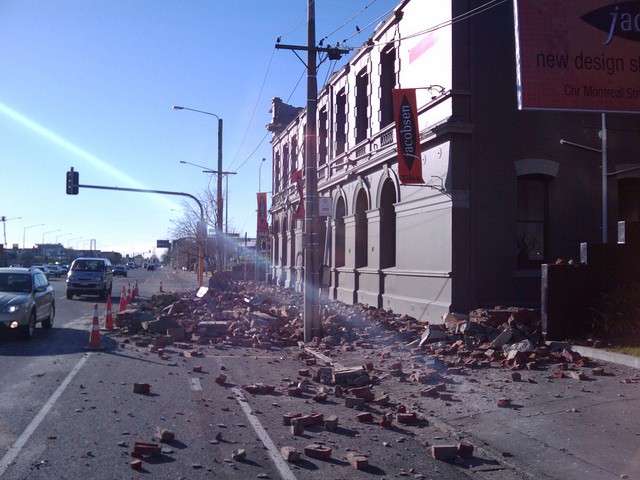Tsunami vs Typhoon – Detailed Comparison

Natural disasters are terrifying and cause huge destruction. Although the marvels of science have allowed human beings to face several perils of nature, there are still many that cause massive damage.
Tsunamis and typhoons are two such natural disasters that harm human life and property. While both are destructive in their own ways, they differ in their formation, intensity, and impact. In this article, we are going to discuss the differences between tsunamis and typhoons.
What is Tsunami?
A tsunami is a series of waves in a water body caused by the sudden displacement of a large volume of water. This is usually caused by earthquakes, volcanic eruptions, and other underwater explosions (detonations, meteorite impacts, etc.). These waves travel across oceans at high speeds and hit coastlines with incredible force.
Normal ocean waves are generated by winds, and tides are generated by the gravitational pull of the Moon and the Sun. Unlike these usual forms of water movement, a tsunami is generated by a huge displacement of water.
Tsunami waves are quite different from normal ocean waves because their wavelengths are much longer. Initially, a tsunami does not look like a breaking wave but instead resembles a rapidly rising tide.
A tsunami usually consists of a series of waves, which arrive in a “wave train” between intervals of minutes to hours. While the impact of tsunamis is limited to coastlines, their overall destruction can be immense as they can affect entire ocean basins.
The 2004 Indian Ocean tsunami killed over 230,000 people and was among the deadliest natural disasters in history.
How is a Tsunami Formed?
A tsunami is formed when a large volume of water is displaced suddenly, usually due to an earthquake or an underwater explosion. The energy released from the earthquake causes the water to move vertically, creating a series of waves that travel outwards.
Unlike normal waves, which are caused by winds, Tsunami waves originate from earthquakes, volcanic eruptions, or other underwater explosions (detonations, landslides, meteorite impact, etc.).
Earthquakes suddenly shift a large area of the seafloor. This disturbance displaces a large amount of water and also releases enormous energy into the ocean. The displacement along with the energy is responsible for the enormous tsunami waves.
Landslides can also cause tsunamis. Just as dropping the ball into a pool creates waves, a huge cliff falling into the sea can create tsunami waves. Underwater explosions also displace water and create tsunamis.
Unlike normal waves, tsunami waves can travel up to 500 miles per hour. In other words, a tsunami on the coast of North America can impact Japan in less than 24 hours. These waves appear small in the open ocean, but as they approach the coast, they grow in height.
Most tsunami waves are under 3m (10 ft.) in height, although they can be up to 500 feet tall; these huge waves are incredibly destructive. Tsunami comes as a series of waves, typically peaking within a few hours of the first wave, and then smaller waves continue for days.
What is a Typhoon?
A typhoon is a type of tropical cyclone that forms over the western North Pacific Ocean. They are characterized by strong winds (exceeding 155 mph) and heavy rainfall, which cause flooding and landslides. Typhoons are known by different names in different regions.
A typhoon is a severe cyclone that forms between 180° and 100°E in the Northern Hemisphere, an area referred to as the Northwestern Pacific Basin. In different regions, typhoons are known by different names.
The term “typhoon” is used in the northwest Pacific. In the northeast Pacific and northern Atlantic, the same phenomenon is called “hurricane”, while those over the Indian oceans are called “cyclone”. In other places, terms like “tropical cyclone” or “severe cyclonic storm” are also used.
A typhoon is a severe, spiral-shaped storm that forms in low-pressure areas. Their severity can be measured using the Saffir-Simpson wind speed scale, with one denoting the least severe and five indicating the most severe.
The strongest typhoons can have winds over 155 mph (250km/h), causing widespread damage to human life and property. Besides strong winds, typhoons bring heavy rainfall, causing flooding and landslides.
How is a Typhoon Formed?
Typhoons are formed over the western North Pacific Ocean where warm ocean waters combine with atmospheric instability to create a cluster of thunderstorms. These intensify and turn into a storm. As the storm gathers energy and moisture, it becomes a destructive typhoon.
Typhoons are formed by the following process:
- Warm Water & Atmospheric Conditions: Western North Pacific Ocean provides warm water (over 81°F/27°C), which provides the energy needed to fuel the storm. This combines with the atmospheric conditions (low pressure, high humidity, and oceanic instability) to push the warm, moist air in the upward direction.
- Coriolis effect: The Coriolis effect is a result of the Earth’s rotation. It causes air to be deflected to the right in the northern hemisphere and the left in the southern hemisphere. Check out this video by Atlas Pro to understand how this leads to winds of different speeds, which in turn lead to storms.
- Tropical Depression: After the above two conditions are met, a cluster of thunderstorms develops over the ocean. As the air rises and cools, it releases heat energy, which fuels and intensifies the storm. With enough intensification, it becomes a tropical depression.
As the tropical depression moves across the ocean, it gathers moisture and energy. By doing so, it turns into a powerful typhoon.
Difference Between Tsunami vs Typhoon
Tsunamis and typhoons differ in their causes, location, and impact.
- Cause: Tsunamis are caused by sudden displacement of water, usually due to earthquakes or underwater explosions. Typhoons are tropical cyclones caused by warm waters and specific atmospheric conditions (low pressure, high humidity, etc.).
- Warning: Tsunamis often strike with little warning. Typhoons, on the other hand, can usually be tracked, allowing people to take protective measures.
- Impact: Tsunamis mostly damage coastal areas. Typhoons can impact all low-lying areas that are prone to flooding.
- Lifespan & Occurrence: Tsunamis can last from 10 mins to 2 hours, with smaller waves following for longer; they usually occur twice every year. Typhoons can last for days or even weeks. Typhoons generally occur around 20 times every year.
- Most Affected Areas: The Pacific Rim (Japan, Indonesia, Philippines) is most affected by Tsunamis. Typhoons, on the other hand, pose the greatest threat to the Western Pacific and Southeast Asia.
Are Tsunamis Caused by Typhoons?
No, tsunamis are not directly caused by typhoons; however, they can indirectly add to the destruction. Tsunamis are caused by a sudden displacement of water, usually due to an earthquake or other underwater explosion.
Tsunami consists of a series of waves caused by a sudden displacement of a large amount of water. This usually occurs due to an earthquake, volcanic eruption, or other underwater explosions (detonations, meteorite impact, etc.).
Typhoons, on the other hand, are cyclones that are caused due to the atmospheric conditions and warm ocean waters of the western North Pacific Ocean.
While a typhoon does not cause a tsunami, it can indirectly exacerbate its impact. For example, if it coincides with a tsunami, it can result in flooding and cause further damage. The typhoon’s heavy rain and strong winds can also hinder rescue efforts in response to the tsunami.
Which is More Dangerous: a Tsunami or a Typhoon?
Both tsunamis and typhoons can cause widespread destruction. Although the 2004 Indian Ocean tsunami was one of the biggest tragedies of human history, most tsunamis are usually far less severe. Typhoons, on the other hand, take many more lives.
During the 2004 Indian Ocean tsunami, ocean waves reached over 100 ft and ravaged 14 countries with incredible force, killing over 230,000 people.
Typhoons, or tropical storms (as they are known in other parts) can be also very destructive. The 1970 Bhola Cyclone in Bangladesh severely flooded the populated areas of the Ganges river delta and killed over half a million people.
While the 2004 Indian Ocean tsunami was incredibly destructive, tsunamis are usually less severe. Because of advancements in technology, now we can get early warnings and take people to higher grounds, ensuring their safety. From 1998 to 2017, about 250,000 people died from tsunamis, mostly from the 2004 tragedy.
In contrast, over 2 million people have lost their lives due to storms in the 20th century. Storms are quite difficult to outrun. Besides causing flooding by waves, storms also cause inland flooding due to heavy rainfall and strong winds.
Nevertheless, both tsunamis and typhoons are dangerous natural disasters. Moreover, due to climate change, our planet is becoming warmer and sea levels are rising. This will make such natural disasters even worse.
Conclusion
In this article, we have looked at the difference between tsunamis and typhoons. Tsunamis are a series of waves formed by a sudden displacement of a large amount of water, usually due to an earthquake or underground explosion. Typhoons are tropical cyclones that form due to the warm ocean water and atmospheric conditions of the western North Pacific Ocean.






